The content of oncidium orchids is very popular among flower growers. One of the most curious representatives of this genus is the yellow oncidium (dancing lady) orchid.
Oncidium varieties and Species differences are pronounced in the color of flowers and even leaves, so you can grow a whole greenhouse, knowing the rules for caring for only one plant.
yellow oncidium orchid Description
Oncidium is a type of orchid. In the natural environment, these beautiful flowers are found in the tropics of South America: they prefer the tops of rocks. They can also be found in savannas or semi-deserts.
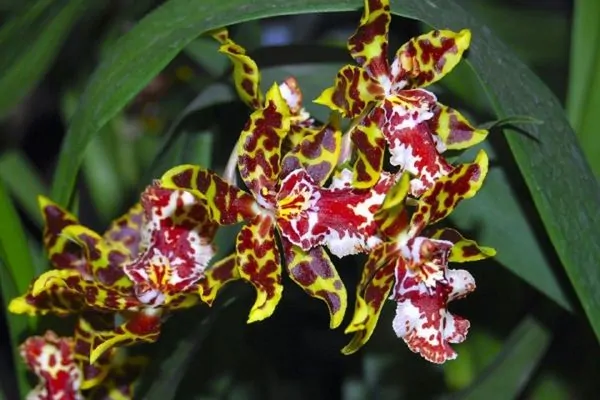
The description of each species differs significantly depending on the color of the leaves, flowers, length of the roots.
All representatives of the genus grow on trees or stones, absorbing moisture and nutrients through aerial roots (epiphytes). In some oncidiums, they are so long that they hang from the pot.
Thick, green roots both sink into the substrate and grow above the trunk along with the leaves. Some of them should always be open to absorb moisture.
Oncidium has the so-called bulbs – thickenings at the roots in the form of a club, from which the leaves begin to grow.
Peduncles are erect or hanging in a long train. The color of the buds belongs mainly to one color scheme: brown-yellow or orange.
The flowers are shaped like flying firebirds or butterflies. The petals differ from each other in size, the lower one is unpaired and the widest.
Oncidium can bloom twice a year, retaining its attractiveness for up to a month. Inflorescences are also used by florists to make bouquets, since after cutting the corollas do not lose their beauty.
Interesting! In addition to being decorative, the flowers exude a pleasant fragrance.
Types of yellow oncidium (dancing lady) orchid
In nature, there are up to 600 species of Oncidium. For indoor conditions, more unpretentious hybrid varieties with bright colors have been bred. The most popular yellow oncidium orchid varieties (species) with photos are described below.
Warty (Oncidium varicosum)
The leaves of this species are quite large, rich green hue. Lemon flowers are formed in large numbers and retain their attractiveness for up to 2 months.
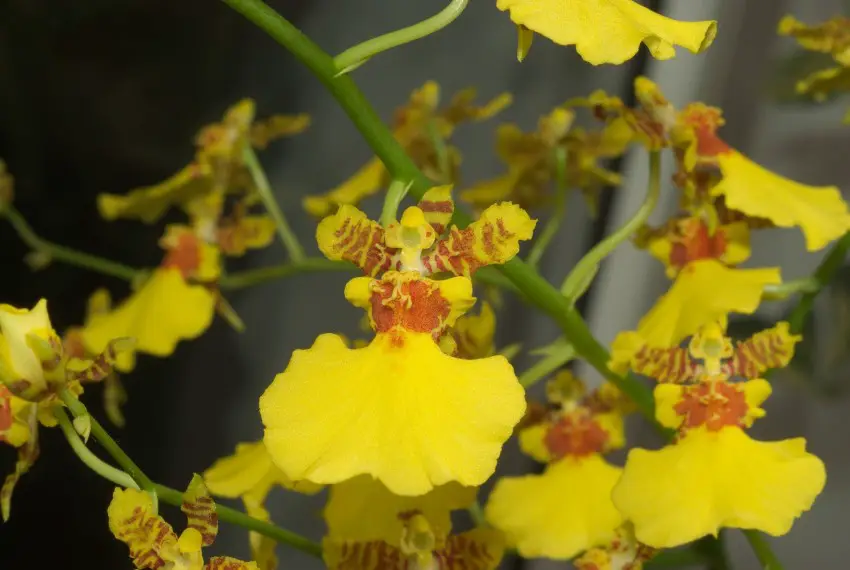
Limming (Oncidium limminghei)
A small peduncle is up to 10 cm long and produces only 1 bud. A blossoming flower reaches 4 cm, the color, as it were, divides it into contrasting halves. For example, the top petals are burgundy brown and the bottom petals are yellow.
The difference between this species is the possibility of year-round flowering: after the bud wilts, a new peduncle begins to grow in the same place.
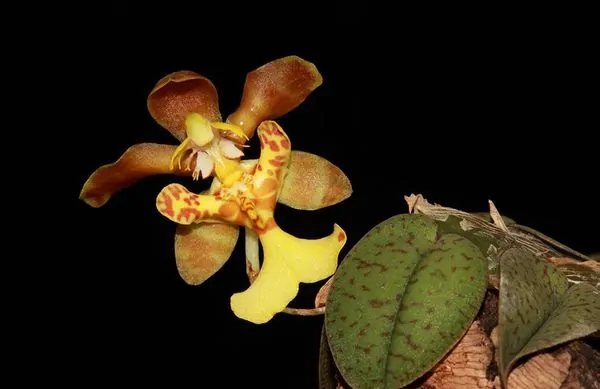
Oncidium sinuous (Oncidium flexuosum)
Spreading foliage is painted in a bright light green color. The flower is yellow, medium size (about 3 cm). On one peduncle, several buds are formed, collected in an inflorescence panicle. Blooms in summer from July to August.
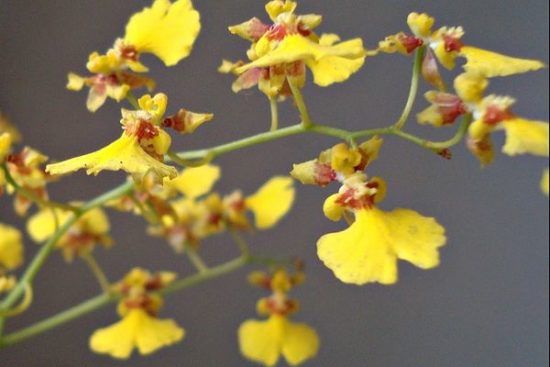
Oncidium beautiful (Oncidium splendidum)
The leaves of the beautiful oncidium are hard and straight. Their color, in addition to green, has purple tints. Yellow flowers bloom simultaneously in 15–20 pieces, each exceeding 5 cm in diameter.
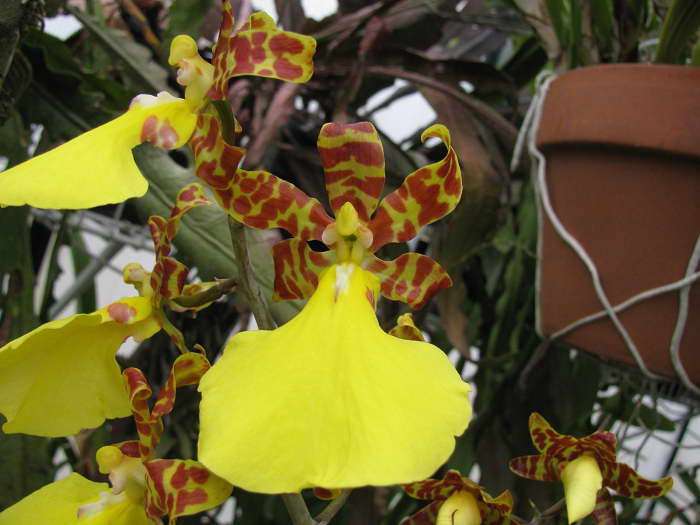
Oncidium tiger (Oncidium tigrinum)
The name of the variety is given for the variegated color of the flowers: on a yellow background, small brown spots are all over the petals.
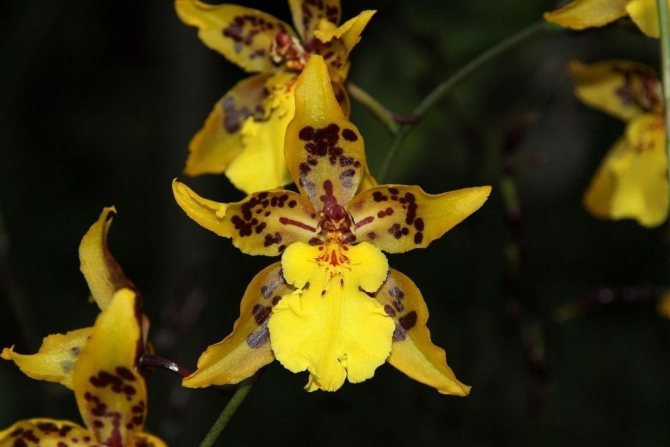
Oncidium papilio (Oncidium papilio)
The flowers of this oncidium are of a very interesting shape and color: the petals are long, with wavy edges. The color is yellow in the center, bright scarlet around the perimeter. A long and thin peduncle raises one such flower high above the foliage, which even more resembles a flying moth.
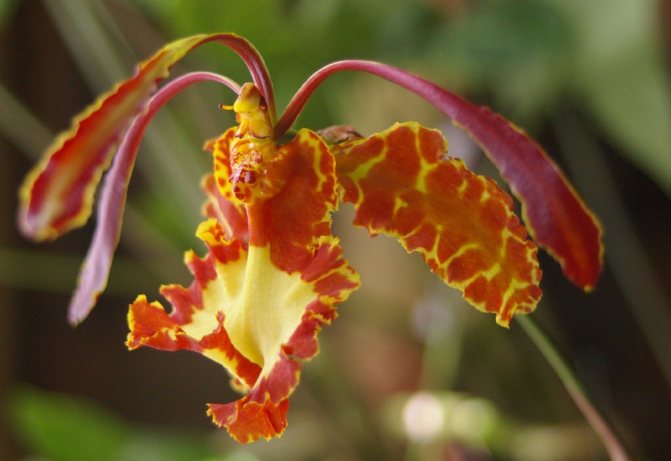
Torch-like, scorched Oncidium (O. sphacelatum)
The leaves of the torch-like oncidium are long, pointed at the top. The peduncle is long and covered with small flowers, forming a falling panicle inflorescence. The buds are brown with contrasting lemon spots.
The plant pleases with its magnificence by the New Year, continuing active flowering until the end of winter.
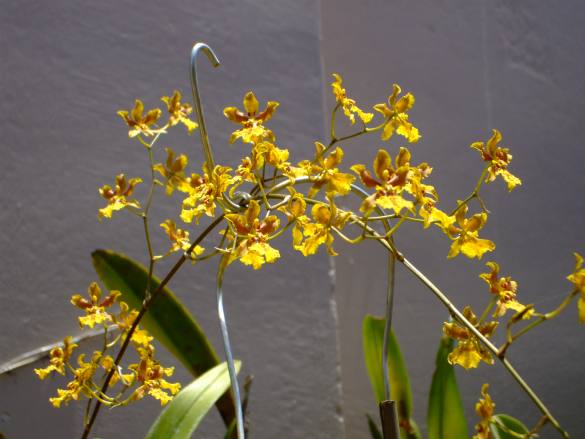
Oncidium curly (Oncidium cricpum)
The flower petals of the curly oncidium are long and wide, with wavy edges. They are painted in several tones: light brown in the upper half along the edge of the lower petal, in the center yellow with red specks.
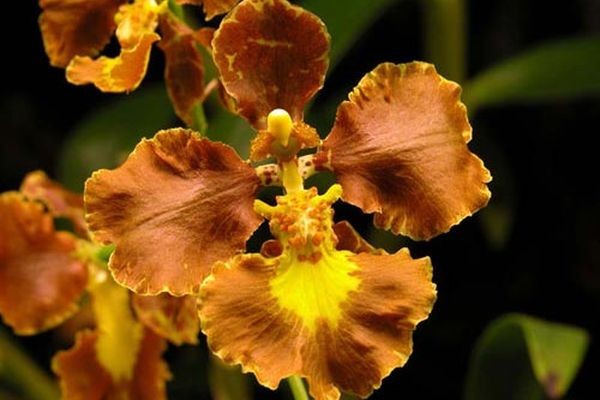
The peduncle grows up to 30 cm, but branches at the top.
Oncidium Sweet Sugar
Oncidium Sweet Sugar is a short representative of the genus. The height, even during the flowering period, does not exceed 40 cm. A large bulb is located in the substrate, from which long and narrow leaves extend. The flowers are bright yellow, up to 3 cm in diameter.
yellow oncidium orchid Transplant after purchase and during further growing season
The first thing you need to pay attention to is the condition of the flower in the store. It must have more than 3 pseudobulbs, since only in this case the flower could form buds without artificial stimulation.
The roots are light green in color. Since most orchids are sold in transparent pots, this is easy to see.
The soil in the container should not be dry or, conversely, sink in water. Leaves of natural color without brown spots and damage.
After the purchase, the oncidium needs a transplant if the roots are too crowded in the pot or the condition of the substrate is poor.
Important! The plant is sensitive to root damage, so it should not be transplanted unless absolutely necessary.
The yellow oncidium orchid transplant is carried out as follows:
- The plant is turned over and shaken out of the pot. Better to hold it by the base.
- The roots are cleaned of the old soil, if it has plaque, mold, lumps or rot.
- Diseased roots are cut off with a sharp knife in places where they are still green.
- While the pot and soil are being prepared, the plant should be placed in water at room temperature for 10-15 minutes.
- A new container needs to be taken more than the previous one by a couple of centimeters.
- A layer of flower drainage is poured at the bottom, and the same layer of new soil is poured on top.
- The plant is taken out of the water, the places of cuts are sprinkled with charcoal powder.
- The oncidium is installed so that the large (old) bulbs are oriented towards one edge, and the new ones towards the center, the voids are covered with a substrate.
Important! Pseudobulbs are left above the surface.
At the end, be sure to check the transplanted flower for stability and, if necessary, install props.
yellow oncidium (dancing lady) orchid Care
Oncidium is considered an unpretentious indoor flower, especially its hybrid varieties. Care at home for the plant comes down to observing the necessary microclimate. For a detailed Yellow oncidium orchid care guide. Here below we also look at short care.
Temperature
Oncidium tolerates temperatures well from 15 ° C in winter to 27 ° C in summer. At the same time, temperature fluctuations during the day are more important for almost all species. A change of even 5 degrees can be detrimental to flowers.
Humidity
Air humidity is not the main microclimate factor for oncidiums. Well, when this figure is in the range of 40-70%. In the summer heat and the absence of an air conditioner, it is useful to spray the plant with water at room temperature. If this is not possible, then a container with liquid is placed next to the flower or wet expanded clay is poured into the pan.
In winter, when the air from the radiators is dry, it is useful to give the plant a warm shower 1-2 times a week. The main thing is not to spray the flowers themselves and take breaks for a dormant period at temperatures below 18 ° C.
In addition to artificially increasing humidity, you need to ventilate the room daily to freshen the air. At the same time, the flower pot is removed away from the window. The procedure improves the microclimate, plus it is a good prevention of fungal diseases and mold.
Lighting
Oncidium needs a lot of diffused light. It is better to protect the flower from direct sunlight so as not to get brown spots on the leaves.
Indirectly, the amount of light is indicated by the color of the leaves. They become dark and dense when the flower needs additional illumination. With the pallor of the leaf plates, the plant must be set aside from the window.
Oncidium can look good even in low light, but still not bloom. Therefore, if the plant stands for a long time without flowers, then you first need to adjust the amount of light.
Substrate for yellow oncidium (dancing lady) orchid
Oncidium needs soil, like orchids. The prepared substrate is sold in stores. Its main component is tree bark in large pieces. Even for self-preparation of the soil, you will need to purchase it. The substrate mixes sphagnum, peat and bark in equal parts. Charcoal is added to prevent fungal infection.
Watering
The watering regimen depends on the stage of flower development. If the growth of leaves begins from a new pseudobulb, then regular moisturizing is required. To do this, the plant is watered from a long watering can so that water does not fall on the leaves.
A more natural way for orchids is to absorb moisture through the wide holes in the bottom of the pot. The plant is placed in a basin of water at 2/3 of the height of the pot for half an hour.
With any method, 15 minutes after watering, excess liquid is drained from the pan. The procedure during the period of active growth is carried out 3 times a week.
When the formation of a new pseudobulb begins, watering is reduced to weekly: this inhibits the growth of the bush and stimulates the laying of flower buds.
top dressing
Top dressing is carried out with ready-made mineral fertilizers for orchids the liquid is diluted with water in half the dose indicated on the package. Fertilizers are applied throughout the period of leaf growth and flowering.
Feeding should be stopped after the peduncle wilts and pseudobulbs begin to form.
pruning
Oncidium pruning may be needed only after the peduncle has withered. If it turns yellow, it is cut at a distance of about 5 cm from the base.
Transfer
Transplantation is carried out only when the roots fill the entire volume of the pot. The flowerpot is selected with large drainage holes at the bottom.
In the new container, the plant is positioned so that the first (oldest) bulb is at the edge, and from the center there is a distance for growing in width.
Advice! The pot should be bought wide and high in order to cover the bottom with a drainage layer.
yellow oncidium (dancing lady) orchid Diseases
Orchids are quite vulnerable to pests. Mealybug, scale insect or tick appear on the leaves . Insects must be mechanically removed with cotton wool and an alcohol solution or soap. Then the entire plant and the soil surface are sprayed with an insecticidal solution, such as Aktara.
The reason why the oncidium dries the peduncle may be that it is covered with leaves from the light.
When the plant is kept in cold or frequent drafts, root rot of a bacterial or fungal nature may appear. The constant stay of the roots in too wet soil also leads to the disease .
The damage is indicated by small brown spots on the leaves and roots. In the early stages, you can save the plant by removing the damaged parts and rearranging the flower in a warm, ventilated place.
yellow oncidium (dancing lady) orchid Propagation methods
It is easy to propagate the oncidium by dividing the bush.
Yellow dancing lady orchid propagation by division of the bush
You can divide a bush with at least 6 bulbs. In this case, half is separated from it, transplanted into another pot and a dry substrate. If necessary, during reproduction, adjacent bulbs are cut with a sharp knife, and the cuts are sprinkled with charcoal.
Advice! A young plant does not need to be watered for the first week so that the process of decay does not begin.
The best time for planting is the beginning of spring.
yellow oncidium Propagation by Pseudobulb jigging
Pseudobulbs in oncidium separate themselves along with the roots. To plant them, you only need to carefully divide the bush according to the number of new shoots and plant them in separate pots.
